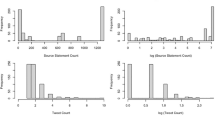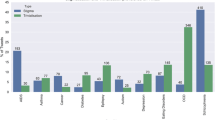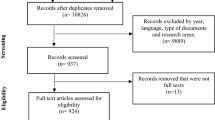Abstract
This paper contributes to the understanding of disasters from the perspective of social media activities. We develop a measure based on Twitter activities that can be used to quantify the evolution of disasters and thus demonstrate temporal–spatial patterns of Twitter activities particularly near the coastline and in large urban areas during Hurricane Sandy. We also show a close relationship between hurricane damages and Twitter activities. Our findings suggest the potential of using social media activities for rapid damage assessment.





Similar content being viewed by others
Notes
This is for twitter API version 1.0. For the latest search API connection address, please visit https://dev.twitter.com/ for details.
References
Ayscue JK (1996) Hurricane damage to residential structures: risk and mitigation. http://www.colorado.edu/hazards/publications/wp/wp94/wp94.html. Accessed 27 Nov 2012
Becker H, Naaman M, Gravano L (2011) Beyond trending topics: real-world event identification on Twitter. In: Proceedings of the fifth international AAAI conference on weblogs and social media. http://www.aaai.org/ocs/index.php/ICWSM/ICWSM11/paper/viewFile/2745/3207. Accessed 17 Jan 2012
Benevenuto F, Magno G, Rodrigues T, Almeida V (2010) Detecting spammers on twitter. In: Collaboration, electronic messaging, anti-abuse and spam conference (CEAS). http://ceas.cc/2010/papers/Paper%2021.pdf. Accessed 17 Jan 2012
Bin O, Kruse JB (2006) Real estate market response to coastal flood hazards. Nat Hazards Rev 7:137–144
Boyd D, Golder S, Lotan G (2010) Tweet, tweet, retweet: conversational aspects of retweeting on Twitter. In: Proceedings of the 43rd Hawaii international conference on social systems (HICSS). 10.1109/HICSS.2010.412
Chapin FS (1974) Human activity patterns in the city: things people do in time and in space. Wiley, New York
Chen C, Neal D, Zhou M (2013) Understanding the evolution of a disaster-a framework for assessing crisis in a system environment (FACSE). Nat Hazards 65:407–422
Chew C, Eysenbach G (2010) Pandemics in the age of Twitter: content analysis of tweets during the 2009 H1N1 outbreak. PLoS One 5:e14118. 10.1371/journal.pone.0014118
Chunara R, Andrews JR, Brownstein JS (2012) Social and news media enable estimation of epidemiological patterns early in the 2010 Haitian cholera outbreak. Am J Trop Med Hyg 86:39–45
Cutter S (2006) Are we asking the right question. In: Perry RW, Quarantelli EL (eds) What is a disaster? New answers to old questions. Lexington, Xlibris, pp 39–48
Federal Emergency Management Agency (2012a) Hurricane sandy impact analysis. http://fema.maps.arcgis.com/home/webmap/viewer.html?webmap=307dd522499d4a44a33d7296a5da5ea0. Accessed 22 July 2013
Federal Emergency Management Agency (2012b) Hazus 2.1 technical and user’s manuals. http://www.fema.gov/media-library/assets/documents/24609. Accessed 13 Dec 2012
Fiegerman S (2012) Twitter now has more than 200 million monthly active users. http://mashable.com/2012/12/18/twitter-200-million-active-users/. Accessed 17 July 2013
Frank MR, Mitchell L, Dodds PS, Danforth CM (2013) Happiness and the patterns of life: a study of geolocated tweets. Sci Rep 3:2625. doi:10.1038/srep02625
Fritz CE (1961) Disasters. In: Merton RK, Nisbet RA (eds) Contemporary social problems: an introduction to the sociology of deviant behavior and social disorganization. Harcourt, Brace & World Inc, New York, pp 651–694
Fritz HM et al (2007) Hurricane Katrina storm surge distribution and field observations on the Mississippi Barrier Islands. Estuar Coast Shelf Sci 74:12–20
Gutro R (2012) NOAA’s GOES-13 satellite shows sandy’s extent. http://www.nasa.gov/mission_pages/hurricanes/archives/2012/h2012_Sandy.html. Accessed 24 July 2013
Holguín-Veras J, Jaller M, Wachtendorf T (2012) Comparative performance of alternative humanitarian logistic structures after the Port-au-Prince earthquake: ACEs, PIEs, and CANs. Transp Res Part A Policy Pract 46:1623–1640
Hong L, Davison BD (2010) Empirical study of topic modeling in Twitter. Proc First Worksh Soc Media Anal. doi:10.1145/1964858.1964870
Hughes AL, Palen L (2009) Twitter adoption and use in mass convergence and emergency events. Int J Emergency Manage 6:248–260
Java A, Song X, Finin T, Tseng B (2007) Why we twitter: understanding microblogging usage and communities. In: Proceedings of the 9th WebKDD and 1st SNA-KDD 2007 workshop on web mining and social network analysis. 10.1145/1348549.1348556
Jelesnianski CP, Chen J, Shaffer WA (1992) SLOSH: sea, lake, and overland surges from hurricanes. NOAA technical report NWS 48. http://slosh.nws.noaa.gov/sloshPub/pubs/SLOSH_TR48.pdf. Accessed 14 July 2012
Kamel NM (2012) Social marginalisation, federal assistance and repopulation patterns in the New Orleans metropolitan area following Hurricane Katrina. Urban Stud 49(14):3211–3231
Kamel NM, Loukaitou-Sideris A (2004) Residential assistance and recovery following the Northridge earthquake. Urban Stud 41(3):533–562
Krishnamurthy B, Gill P, Arlitt M (2008) A few chirps about twitter. Proc First Worksh Online Soc Netw. doi:10.1145/1397735.1397741
Leetaru K, Wang S, Cao G, Padmanabhan A, Shook E (2013) Mapping the global Twitter heartbeat: the geography of Twitter. First Monday. http://firstmonday.org/article/view/4366/3654. Accessed 17 July 2013
Li Y, Zhang M (1997) Dynamic coupling of wave and surge models by Eulerian–Lagrangian method. J Waterw Port Coast Ocean Eng 123:1–7
Library of Congress (2013) Update on the Twitter archive at the library of congress. http://www.loc.gov/today/pr/2013/files/twitter_report_2013jan.pdf. Accessed 17 July 2013
Lutgendorf SK et al (1995) Physical symptoms of chronic fatigue syndrome are exacerbated by the stress of Hurricane Andrew. Psychosom Med 57:310–323
Mousavi ME, Irish JL, Frey AE, Olivera F, Edge BL (2011) Global warming and hurricanes: the potential impact of hurricane intensification and sea level rise on coastal flooding. Clim Change 104:575–597
National Weather Service (2012) Post-tropical cyclone SANDY advisory number 34. http://www.hpc.ncep.noaa.gov/tropical/tropical_advisories.php?storm=SANDY&adnum=34&dt=2012103021&status=posttrop. Accessed 13 Dec 2012
Neal DM (2004) Social time and disasters. Annual Meeting of the American Sociological Association, San Francisco
Ngak C (2012) Hurricane Sandy: latest updates via social media. http://www.cbsnews.com/8301-205_162-57542014/hurricane-sandy-latest-updates-via-social-media/. Accessed 13 Dec 2012
Norris FH, Uhl GA (1993) Chronic stress as a mediator of acute stress: the case of Hurricane Hugo. J Appl Soc Psychol 23:1263–1284
Ovadia S (2009) Exploring the potential of Twitter as a research tool. Behav Soc Sci Librar 28:202–205
Perry RW, Quarantelli EL (2006) What is a disaster? New answers to old questions. Xlibris Corporation, Lexington
Poulsen K (2007) Firsthand reports from California wildfires pour through Twitter. http://www.wired.com/threatlevel/2007/10/firsthand-repor/. Accessed 10 Dec 2012
Quarantelli EL (1987) What should we study? Questions and suggestions for researchers about the concept of disasters. Int J Mass Emerg Disasters 5:7–32
Quarantelli EL (1998a) Epilogue: where we have been and where we might go. In: Quarantelli EL (ed) What Is a disaster: perspectives on the question. Routledge, New York, pp 234–273
Quarantelli EL (1998b) What is a disaster. Routledge, New York
Quarantelli EL (2000) Emergencies, disaster and catastrophes are different phenomena. http://udspace.udel.edu/bitstream/handle/19716/674/PP304.pdf?sequence=1. Accessed 23 June 2012
Quarantelli EL (2005) A social science research agenda for the disasters of the 21st century: theoretical, methodological and empirical issues and their professional implementation. In: Perry RW, Quarantelli EL (eds) What is a disaster: new answers to old questions. Xlibris Corporation, Bloomington, pp 325–396
Ramage D, Dumais ST, Liebling DJ (2010) Characterizing microblogs with topic models. In: Proceedings of the fourth international AAAI conference on weblogs and social media. http://www.aaai.org/ocs/index.php/ICWSM/ICWSM10/paper/viewFile/1528/1846. Accessed 19 Dec 2012
Rhodes J (2010) Managing the parameters of visibility: the revelations of Katrina. Urban Stud 47(10):2051–2068
Sakaki T, Okazaki M, Matsuo Y (2010) Earthquake shakes Twitter users: real-time event detection by social sensors. In: Proceedings of the 19th international conference on World Wide Web. doi:10.1145/1772690.1772777
Shen J, Zhang K, Xiao C, Gong W (2006) Improved prediction of storm surge inundation with a high-resolution unstructured grid model. J Coastal Res 22:1309–1319
Signorini SR, Wei JS, Miller CD (1992) Hurricane-induced surge and currents on the Texas-Louisiana shelf. J Geophys Res Oceans 97:2229–2242
Smith AB, Katz RW (2013) US billion-dollar weather and climate disasters: data sources, trends, accuracy and biases. Nat Hazards 67(2):387–410
Spiro E, Irvine C, DuBois C, Butts C (2012) Waiting for a retweet: modeling waiting times in information propagation. In: 2012 NIPS workshop of social networks and social media conference. http://snap.stanford.edu/social2012/papers/spiro-dubois-butts.pdf. Accessed 12 Dec 2012
Sriram B, Fuhry D, Demir E, Ferhatosmanoglu H, Demirbas M (2010) Short text classification in twitter to improve information filtering. In: Proceedings of the 33rd international ACM SIGIR conference on research and development in information retrieval. 10.1145/1835449.1835643
Starbird K, Palen L (2010) Pass it on? Retweeting in mass emergencies. In: Proceedings of conference on information systems on crisis response and management (ISCRAM 2010). http://www.cs.colorado.edu/~palen/starbirdpaleniscramretweet.pdf. Accessed Dec 12 2012
Starbird K, Palen L, Hughes AL, Vieweg S (2010) Chatter on the red: what hazards threat reveals about the social life of microblogged information. In: Proceedings of the 2010 ACM conference on computer supported cooperative work. doi:10.1145/1718918.1718965
Steyvers M, Griffiths T (2007) Probabilistic topic models. In: Landauer T, McNamara D, Dennis S, Kintsch W (eds) Handbook of latent semantic analysis. Lawrence Erlbaum, Mahwah, pp 424–440
Sullivan KD, Uccellini LW (2012) Service assessment: hurricane/post-tropical cyclone Sandy, October 22–29, 2012. http://www.nws.noaa.gov/os/assessments/pdfs/Sandy13.pdf. Accessed 23 July 2012
Sutton J et al (2013) Tweeting the spill: online informal communications, social networks, and conversational microstructures during the Deepwater Horizon Oilspill. Int J Inf Syst Crisis Response Manag 5:58–76
Taramelli A, Pasqui M, Melelli L, Santini M, Sorichetta A (2011) Modelling hurricane related hazards and risk through GIS for early warning systems. In: Lupo A (ed) Recent hurricane research—climate, dynamics, and societal impacts. InTech, Rijeka
Vested HJ, Jensen HR, Petersen HM, Jørgensen AM, Machenhauer B (1992) An operational hydrographic warning system for the North Sea and the Danish Belts. Cont Shelf Res 12:65–81
Vieweg S, Hughes AL, Starbird K, Palen L (2010) Microblogging during two natural hazards events: what twitter may contribute to situational awareness. Proc SIGCHI Conf Hum Factors Comput Syst. doi:10.1145/1753326.1753486
Wachtendorf T, Kendra JM (2005) Improvising disaster in the city of jazz: organizational response to Hurricane Katrina. http://forums.ssrc.org/understandingkatrina/improvising-disaster-in-the-city-of-jazz-organizational-response-to-hurricane-katrina/. Accessed 10 July 2013
Weng J, Lim EP, Jiang J, He Q (2010) Twitterrank: finding topic-sensitive influential twitterers. Proc Third ACM Int Conf Web Search Data Min. doi:10.1145/1718487.1718520
Wood SA, Guerry AD, Silver JM, Lacayo M (2013) Using social media to quantify nature-based tourism and recreation. Sci Rep 3:2976. doi:10.1038/srep02976
Zhao WX et al (2011) Comparing twitter and traditional media using topic models. In: Clough P et al (eds) Advances in information retrieval. Springer, Dublin, pp 338–349
Acknowledgments
Funding for this project from the National Science Foundation (CMMI-1200275) is greatly appreciated. We thank Douglas Bausch at Federal Emergency Management Agency for providing a key data source on Sandy-related damages and Dorothy Reed at the University of Washington for providing us with the power outage data. We also thank two anonymous reviewers for their helpful comments.
Author information
Authors and Affiliations
Corresponding author
Rights and permissions
About this article
Cite this article
Guan, X., Chen, C. Using social media data to understand and assess disasters. Nat Hazards 74, 837–850 (2014). https://doi.org/10.1007/s11069-014-1217-1
Received:
Accepted:
Published:
Issue Date:
DOI: https://doi.org/10.1007/s11069-014-1217-1




